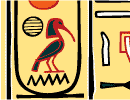|
Click Here to Create a Custom Cartouche of Your Name or Phrase with the Fun and Popular Hieroglyph Translator
NEW KINGDOM
1570 B.C. - 1070 B.C.
|
Keys to this period
1) King Ahmose reunifies Upper and Lower Egypt!
2) The term pharoh applied to king
3) Queen Hatshepsut the only female Pharoh!
4) Tombs of Ancestors - now buried in The Valley of the Kings
5) King Tutankhamun the youngest and most famous Pharoh!
6) King Akhenaten the strangest of the Pharohs, established a new religious order - that of the sun god (Aten). He was seen as an outcast. His famous wife Nefertiti was the Queen!
Summary
The New Kingdom's first king was Ahmose who reunified Upper and Lower Egypt. This was another #000000en Age for Egypt as it expanded its empire. Memphis was the administrative capital again. The term pharaoh began being applied to the king.
Queen Hatshepsut became pharaoh by default while acting as regent for a young Tuthmosis III (at right). He eventually came to power and became the "Napoleon" of ancient Egypt. The empire spread far to the south into ancient Nubia (south of modern Aswan and into northern Sudan), while in the north the territory under control was expanded well into the Near East.
It was in the New Kingdom that most of the pharaohs' tombs were located in the Valley of the Kings and their mortuary temples were separately located. Egypt became incredibly wealthy through trade and foreign conquests. The country's religious orders also benefited - particularly that of the state god Amun-Re with its powerful clergy and vast temples and estates.
The existing religious orders were deposed for a while during the 14th century B.C. when the heretic king Akhenaten established a new religious order - that of the sun god Aten. The old temples were abandoned and a new capital, Akhetaten, was established to the north. Attention to international affairs waned.
Soon after the death of Akhenaten, his probable son - Tutankhaten - became pharaoh at about the age of nine. His was a short reign, but the old religious orders rose again and Akhenaten's city was destroyed. Tutankhaten's name was changed to Tutankhamun, but his reign was no more than nine years.
Several years later, a general by the name of Horemheb came to power and started a campaign to eliminate evidence of his immediate predecessors. His successor was Ramesses I who was the first in a long line of Ramesside kings in the 19th and 20th Dynasties. His grandson, Ramesses II, became one of Egypt's greatest builders.
By the 20th Dynasty the power of the pharaohs had waned and there were battles with invaders called the Sea Peoples. Egypt would never rule again with the same power. Ramesses XI was the last of the rulers of the New Kingdom. The Theban priesthood virtually controlled Upper Egypt by the end of the New Kingdom, while the pharaoh had ruled from the Delta.
|
|
|

|

All trademarks and copyrights on this page are owned by their respective owners.
The Rest Copyright 1998-2012 All Rights Reserved www.Virtual-Egypt.com
|
|

|
|
Macromedia Flash
Hieroglyphic
Translator

Macromedia Flash
Hieroglyphic
Screen Saver

|
|
|





